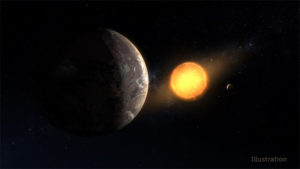 NASA scientists announced Wednesday that they’ve discovered an Earth-size exoplanet that is remarkably similar to our planet.
NASA scientists announced Wednesday that they’ve discovered an Earth-size exoplanet that is remarkably similar to our planet.
NASA says a team of transatlantic scientists were looking through old observations from the now-retired Kepler space telescope when they discovered the planet, Kepler-1649c, orbiting in its star’s habitable zone. That’s an area where a rocky planet could support liquid water.
Out of all the exoplanets found by the Kepler telescope, NASA says this distant world – located 300 light-years from us – is most similar to Earth in size and estimated temperature.
“This intriguing, distant world gives us even greater hope that a second Earth lies among the stars, waiting to be found,” said Thomas Zurbuchen, associate administrator of NASA’s Science Mission Directorate in Washington.
NASA says the newly revealed world is only 1.06 times larger than Earth and the exoplanet’s temperature may be similar to our planet’s, because of the amount of starlight it receives.
However, unlike Earth, NASA says this exoplanet orbits a red dwarf, a type of star that is known for stellar flare-ups that may make a planet’s environment challenging for any potential life.
Kepler-1649c orbits its small red dwarf star so closely that a year on Kepler-1649c is equivalent to only 19.5 Earth days.
There are other exoplanets estimated to be closer to Earth in size and in temperature, but NASA says there is no other exoplanet that is considered to be closer to Earth in both of these values that also lies in the habitable zone of its system.
